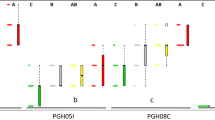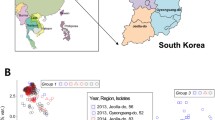Abstract
A study was made of the biological interactions between an isolate of Peronospora parasitica compatible with Brassica juncea and two isolates of Albugo candida either incompatible or compatible with the host species. Prior inoculation with the incompatible isolate of A. candida induced resistance to subsequently inoculated P. parasitica. The degree of resistance was proportional to the zoosporangia concentration of the incompatible isolate and induced resistance was more marked in the cotyledon receiving the inducing inoculum compared to the opposite cotyledon and subsequently emerging true leaves that had not been pre-inoculated. Induction of resistance was also observed if the incompatible isolate of A. candida and P. parasitica were co-inoculated simultaneously. However, the effect was greater the longer the interval between inoculations, up to a period of 4 days. When the incompatible isolate of A. candida was inoculated 4h after P. parasitica, there was no marked effect on resistance to the latter. In contrast, prior inoculation with the compatible isolate of A. candida increased susceptibility to P. parasitica inoculated subsequently. However, pre- or co-inoculation with P. parasitica suppressed the development of the compatible isolate of A. candida. A spectrum of responses was observed when one cotyledon was inoculated simultaneously with both the incompatible and compatible isolates of A. candida and followed subsequently with P. parasitica after different time intervals. In such combinations, a transition was observed in the host response to P. parasitica from induced resistance/reduced susceptibility, which increased up to 24h following a simultaneous inoculation with incompatible + compatible isolates of A. candida to an almost neutral reaction after 72h to induced susceptibility after 96h. This range of altered responses appeared to reflect the outcome of the differing kinetics and counter-effects of resistance and susceptibility induction.
Similar content being viewed by others
References
Adhikari KN and McIntosh RA (1998) Susceptibility in oats to stem rust induced by co-infection with leaf rust. Plant Pathology 47: 420–426
Arase S and Fujita K (1992) Induction of inaccessibility to Pyricularia oryzae by pre-inoculation of P. grisea in rice leaf-sheath cells. Journal of Phytopathology 134: 97–102
Awasthi RP, Nashaat NI, Heran A, Kolte SJ and Singh US (1997) The effect of Albugo candida on resistance to Peronospora parasitica and vice-versa in rapeseed-mustard. In: Abstracts ISHS Symposium on Brassicas: 10th Crucifer Genetics Workshop (p 49) ENSAR-INRA, Rennes, France
Bisht IS, Agrawal RC and Singh R (1994) White rust (Albugo candida) severity in mustard (Brassica juncea) and its effect on seed yields. Plant Varieties and Seeds 7: 85–89
Bostock RM, Karban R, Thaler JS, Weyman PD and Gilchrist D (2001) Signal interaction in induced resistance to pathogens and insect herbivores. European Journal of Plant Pathology 107: 103–111
Channon AG (1981) Downy mildewof Brassicas. In: Spencer DM (ed) The Downy Mildews (pp 321–339) Academic Press, London
Dahiya JS and Woods DL (1987) Phytoalexin accumulation in rapeseed leaves challenged with white rust (Albugo candida). Canadian Journal of Plant Pathology 9: 276 (Abstract)
Dixelius C (1994) Presence of pathogenesis-related proteins 2, Q and S in stressed Brassica napus and Brassica nigra plantlets. Physiological and Molecular Plant Pathology 44: 1–8
Doughty KJ, Porter AJR, Morton AM, Kiddle G, Bock CH and Wallsgrove RM (1991) Variation in the glucosinolate content of oilseed rape (Brassica napus L.) leaves. II. Response to infection by Alternaria Brassica (Berk.) Sacc. Annals of Applied Biology 118: 469–477
Holub E, Crute I, Brose E and Beynon J (1993) Identification and mapping of loci on Arabidopsis for resistance to downy mildew and white blister. In: Davis KR and Hammerschmidt R (eds) Arabidopsis thaliana as a Model for Plant-Pathogen Interactions. American Phytopathological Society Symposium Series. APS Press, Minnesota
Kochman JK and Brown JF (1975) Studies on the mechanism of cross-protection in cereal rusts. Physiological Plant Pathology 6: 19–27
Kolte SJ (1985) Rapessed-mustard and Sesame Diseases. Diseases of Annual Edible Oilseed Crops, Vol. II. CRC Press, Boca Raton, Florida
Lyngs Jørgensen HJ, Andresen H and Smedegaard-Petersen V (1996) Control of Drechslera teres and other barley pathogens by pre-inoculation with Bipolaris maydis and Septoria nodorum. Phytopathology 86: 602–607
Manandhar HK, Lyngs Jørgensen HJ, Mathur SB and Smedegaard-Petersen V (1998) Suppression of rice blast by pre-inoculation with avirulent Pyricularia oryzae and the non-rice pathogen Bipolaris sorokiniana. Phytopathology 88: 735–739
Mathur S, Wu CR and Rimmer RS (1995) Pathogenic variation among Albugo candida isolates from Western Canada. Phytopathology 85: 1175 (Abstract)
Mauch-Mani B and Slusarenko AJ (1994) Systemic acquired resistance in Arabidopsis thaliana induced by a predisposing infection with a pathogenic isolate of Fusarium oxysporum. Molecular Plant-Microbe Interactions 7: 378–383
Moseman JG, Scharen AL and Greeley LW (1965) Propagation of Erysiphe graminis f. sp. tritici on barley and Erysiphe graminis f. sp. hordei on wheat. Phytopathology 55: 92–96
Nashaat NI and Awasthi RP (1995) Evidence for differential resistance to Peronospora parasitica (downy mildew) in accesions of Brassica juncea (mustard) at the cotyledon stage. Journal of Phytopathology 143: 157–159
Nashaat NI and Rawlinson CJ (1994) The response of oilseed rape (Brassica napus ssp. oleifera) accessions with different glucosinolate and erucic acid contents to four isolates of Peronospora parasitica (downy mildew) and the identification of new sources of resistance. Plant Pathology 43: 278–285
Oostendorp M, Kunz w, Dietrich B and Staub T (2001) Induced disease resistance in plants by chemicals. European Journal of Plant Pathology 107: 19–28
Ouchi S, Oku H, Hibino C and Akiyama I (1974) Induction of accessibility and resistance in leaves of barley by some races of Erysiphe graminis. Phytopathologische Zeitschrit 79: 24–34
Paul VH and Rawlinson CJ (1992) Disease and Pests of Rape. Verlag Th. Mann, D-4650 Gelsenkirchen-Buer
Petrie GA (1988) Races of Albugo candida (white rust and staghead) on cultivated Cruciferae in Saskatchewan. Canadian Journal of Plant Pathology 10: 142–150
Pidskalny RS and Rimmer SR (1985) Virulence of Albugo candida from turnip rape (Brassica campestris) and mustard (B. juncea) on various crucifers. Canadian Journal of Plant Pathology 7: 283–286
Rouxel T, Kollman A and Balesdent M (1995) Phytoalexins from the crucifers. In: Daniel M and Purkayastha R (eds) Handbook of Phytoalexins Metabolism and Action (pp 229–261) Marcel Dekker Inc., New York
Saharan GS and Verma PR (1992) White Rusts. A Review of Economically Important Species. International Devevelopment Research Centre, Ottawa, Canada
Sherriff C and Lucas J (1987) Variation in host specificity in the Brassica population of Peronospora parasitica. In: Day PR and Jellis GJ (eds) Genetics and Plant Pathogenesis (pp 333–335) Blackwell Scientific Publications, Oxford
Silué D, Nashaat NI and Tirilly Y (1996) Differential response of Brassica oleracea and B. rapa accessions to seven isolates of Peronospora parasitica at the cotyledon stage. Plant Disease 80: 142–144
Singh US, Doughty KJ, Nashaat NI, Bennett RN and Kolte SJ (1999) Induction of systemic resistance to Albugo candida in Brassica juncea by pre-or co-inoculation with an incompatible isolate. Phytopathology 89: 1226–1232
Sylvester-Bradley R (1985) Revision of a code for stages of development in oilseed rape (Brassica napus L.). Aspects Applied Biology 10: 395–400
Vishunavat K, Nashaat NI, Heran A and Kolte SJ (1998) Sensitivity to the racemic mixture and isomeric forms of metalaxyl in Indian and European homothallic and heterothallic isolates of Peronospora parasitica in Brassica species. Crop Protection 17(6): 543–546
Author information
Authors and Affiliations
Corresponding author
Rights and permissions
About this article
Cite this article
Singh, U., Nashaat, N., Doughty, K. et al. Altered Phenotypic Response to Peronospora parasitica in Brassica juncea Seedlings Following Prior Inoculation with an Avirulent or Virulent Isolate of Albugo candida . European Journal of Plant Pathology 108, 555–564 (2002). https://doi.org/10.1023/A:1019937115378
Issue Date:
DOI: https://doi.org/10.1023/A:1019937115378




